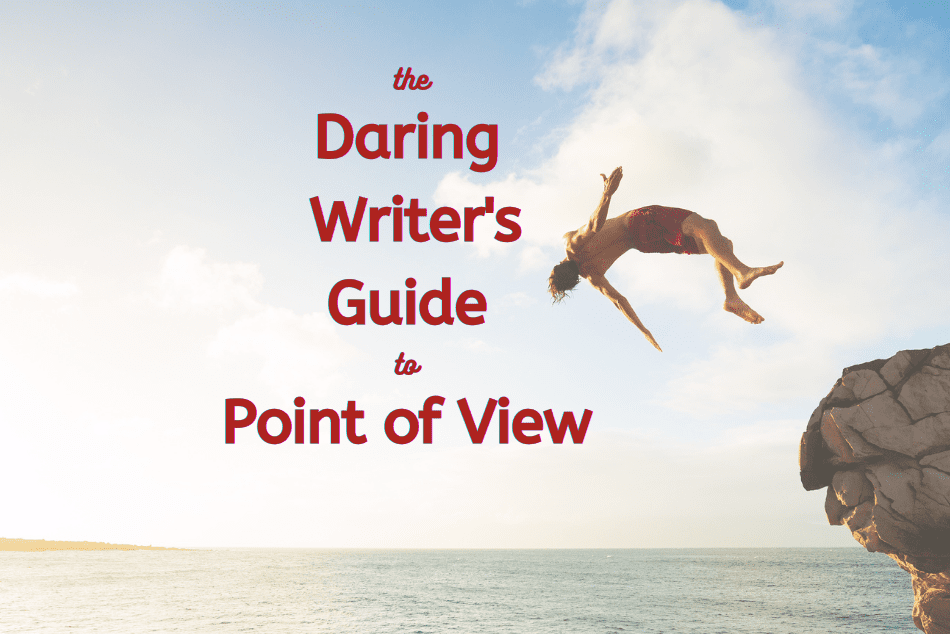Point of view issues keep more otherwise sellable authors from selling their work than nearly any other problem. That’s why as an agent, author, and writing teacher, I always caution my clients, fellow writers, and students to play it safe when it comes to POV. And yet every once in a while I come across a story whose author threw caution to the wind so splendidly I am tempted to play around with point of view myself. If you find yourself so inclined, read on.
FIRST, THE RULES
As Picasso reminded us, “Learn the rules like a pro, so you can break them like an artist.” Here are the POV rules you need to observe long enough to master them before you break them:
1) No omniscient POV. (It’s considered old-fashioned these days, at least here in the U.S.)
2) When writing first-person, stick to one POV per book.
3) When writing third-person:
a) Stick to third-person close;
b) Use only one POV per scene;
c) Use no more than five POVs per book; and
d) The protagonist’s POV should predominate.
Note: For more on the kinds of POV, see this post by editor extraordinaire Dana Isaacson.
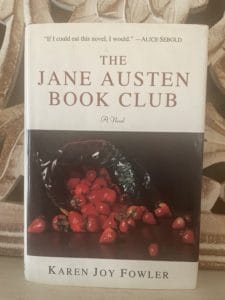 BREAKING THE RULES
BREAKING THE RULES
A caveat: The following explores how a few bestselling authors far more skilled than I—and probably you, too—took POV risks that worked big-time. So if this your first rodeo, you’re better off writing by the aforementioned rules. But sooner or later, regardless of your skill level, you’re going to want to break the rules. When you do, remember these examples of stories where the novelists’ POV gambles paid off.
FIRST-PERSON PLURAL POV
In two of my favorite novels of all time, the authors use first-person plural POV (we/us). In The Jane Austen Book Club, Karen Joy Fowler writes the story from the book club’s point of view. The book club members meet every month to discuss a Jane Austen novel, with unpredictable consequences for them all. (This 2004 novel is a must for all Austen fans; the film adaptation’s is fun, too, if not particularly faithful.) Here’s the opening:
Each of us has a private Austen.
Jocelyn’s Austen wrote wonderful novels about love and courtship, but never married. The book club was Jocelyn’s idea, and she handpicked the members…. We suspected a hidden agenda, but who would put Jane Austen to an evil purpose?
Irresistible, and we the readers fall in love with the literary, gossipy voice.
The same is true for Unlikely Animals, Annie Hartnett’s second novel, published just last month. A sort of “Our Town meets Alice Hoffman with a touch of John Irving,” this wonderful novel is written from the point of view of the dead people in the cemetery of the small New Hampshire town where the story is set. Which may sound morbid, but is not, as you can see from the opening lines:
Maple Street Cemetery
Everton, NH
43.3623° N, 72.1662° W
Years later, when people in Everton would tell this story, they would say it was Clive Starling who called the reporter, the way that man loved attention.
But we remember the way it happened….
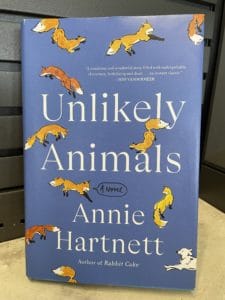
Again, irresistible. We want to hear the real story, as told by the dearly departed, who know this town—past and present—better than anyone.
SECOND-PERSON POV
This POV (you/you) is rare, at least from my point of view. Only one immediately came to mind—Bright Lights, Big City, by Jay McInerney. This 1984 novel grabs readers from the very beginning, promising a ride as wild as the Eighties:
You are not the kind of guy who would be at a place like this at this hour of the morning. But here you are, and you cannot say that the terrain is entirely unfamiliar, although the details are fuzzy. You are at a nightclub talking to a girl with a shaved head.
And we’re off on the journey with McInerney, because we’re not that kind of guy either….and yet.
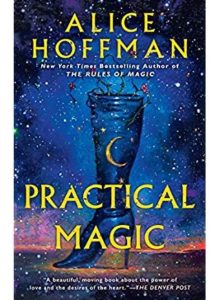
OMNISCIENT POV
Omniscient point of view is “Author as God.” Think 19th century novels, and fairy tales: Once upon a time there was a girl…. “Author as God” has fallen out of fashion in the 21st century, most notably in the United States. You still see it sometimes, especially in science fiction, fantasy, historical fiction, and literary fiction.
No one does it better than Alice Hoffman, who writes modern-day fairy tales, a kind of “Yankee magic realism,” a literary legacy she has attributed to Nathaniel Hawthorne. You can see why in the opening to Practical Magic, the 1995 novel I reread whenever I’m feeling blue:
For more than two hundred years, the Owens women have been blamed for everything that has gone wrong in town. If a damp spring arrived, if cows in the pasture gave milk that was runny with blood, if a colt died of colic or a baby was born with a red birthmark stamped onto his cheek, everyone believed that fate must have been twisted, at least a little, by those women over on Magnolia Street.
Hoffman has us at “the Owens women.” The scope and timelessness of the novel are part of its attraction, and the omniscient POV helps her establish both.
MULTIPLE FIRST-PERSON POV
Conventional wisdom has it that if you’re writing first-person point of view, you should stay with that one POV for the entire novel, if only so readers know whose head they’re in the whole time. Mixing it with third-person is tricky enough, but using more than one first-person point of view can be very confusing for readers if it’s not done with finesse.
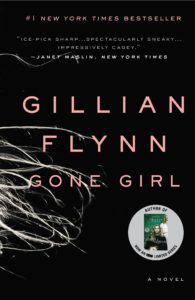
But when Gillian Flynn used his-and-her first-person points of view in her blockbuster thriller Gone Girl, writers took note—and we’ve been flooded with multiple first-person novels ever since. As an agent, I see a lot of them, and mostly it doesn’t work. Gillian Flynn made it work, by making the voices of the husband and wife characters very different—and by first introducing the wife’s POV through diary entries. The diary entries not only help the reader remember who’s who, but in Flynn’s capable hands, they also serve as a clever plot device.
Speaking of devices, Maria Semple’s Where’d You Go, Bernadette is a master class in these tools. This book club favorite, technically told from the first-person point of view of an eighth grader named Bee, opens with Bee’s report card, just one of the dozens of devices Semple uses over the course of the story that become, in effect, other POVs. (For more, see the full list in my book on story openings, The Writer’s Guide to Beginnings.)
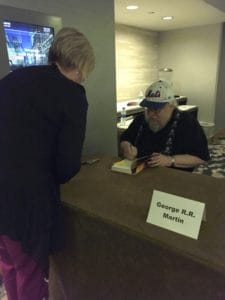
George R. R. Martin signing a book for my son, for whom A Game of Thrones was the gateway to reading.
MULTIPLE THIRD-PERSON CLOSE POV
Nobody breaks the rules as beautifully as George R. R. Martin. When to my chagrin one of my clients changed points of view half a dozen times in the opening of her novel and cited A Game of Thrones as her model, I went right to my copy of the epic fantasy. And yes, in the first fifty pages alone, Martin changes points of view at least five times (the conservative limit for an entire book). But it’s neither choppy nor confusing—it’s brilliant.
Martin keeps the reader reading, through the skilled use of compelling action, likable POV characters, and clear links from one chapter to the next. I was so thrilled by his masterful handling of POV that I sat down and wrote a detailed analysis of his opening for my client (which you’ll also find in The Writer’s Guide to Beginnings). So it can be done, and done effectively, but most easily if you’re George R. R. Martin. I’m just saying.
GO FOR IT
For the record, I still say it’s risky to break the POV rules, especially if you’re writing your debut. But ultimately, all writing is risky. And the more we write, the more challenges we like to present ourselves. Point of view may be one of the challenges you take on in your next work. I have the terrible feeling it may be in mine. But as we’ve seen, other writers have met that challenge with grace and grit. With a little luck and creativity of our own, we can, too. Let’s give it a try.
You go first.
Join us on Facebook to talk more point of view.

